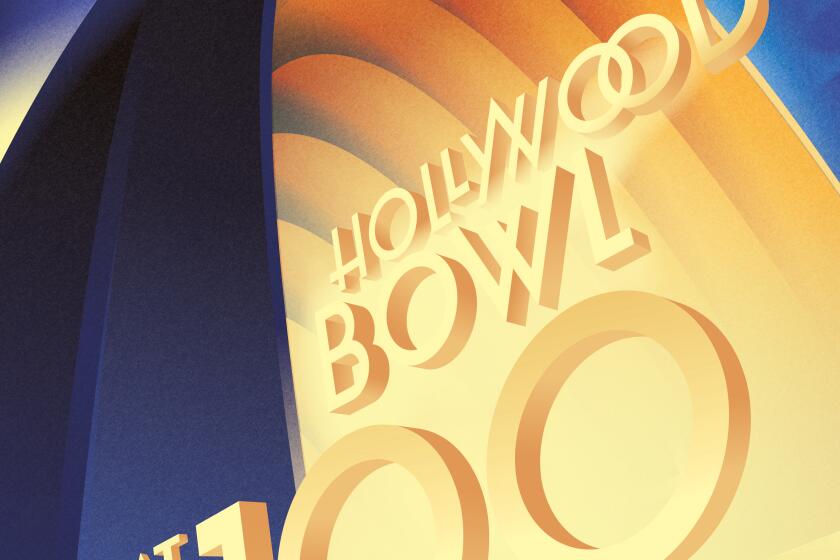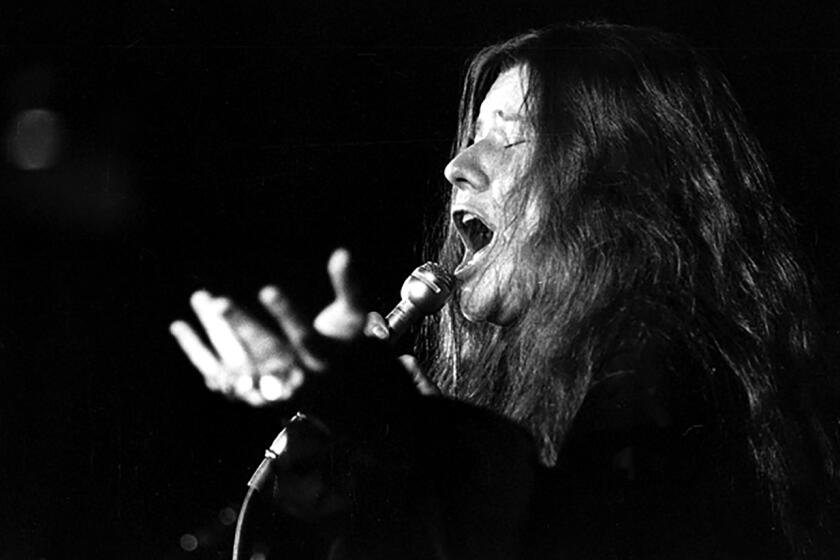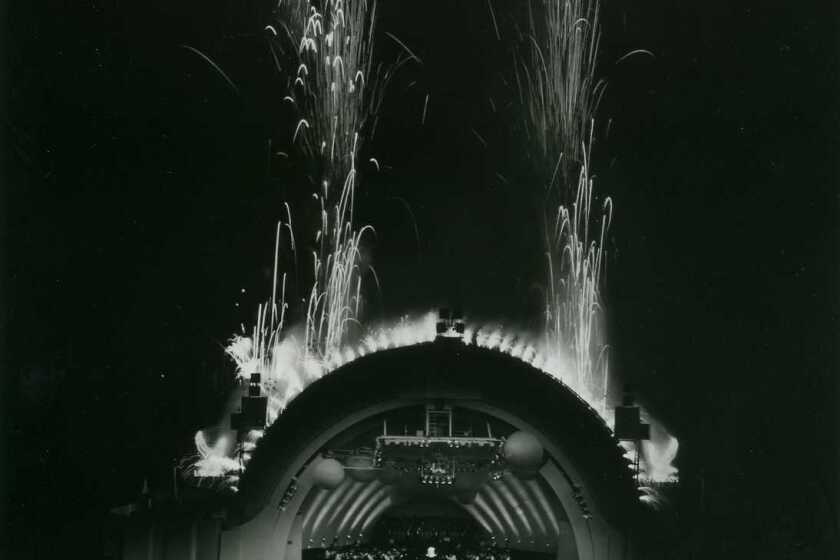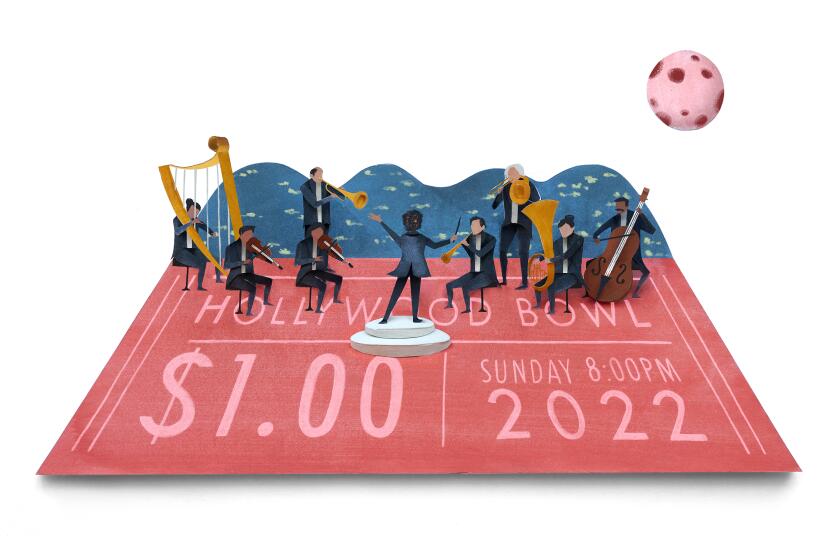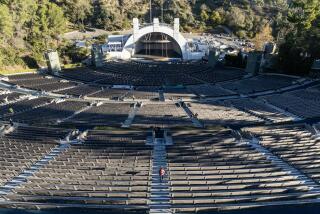From the Beatles to Adele, 20 unforgettable Hollywood Bowl concerts
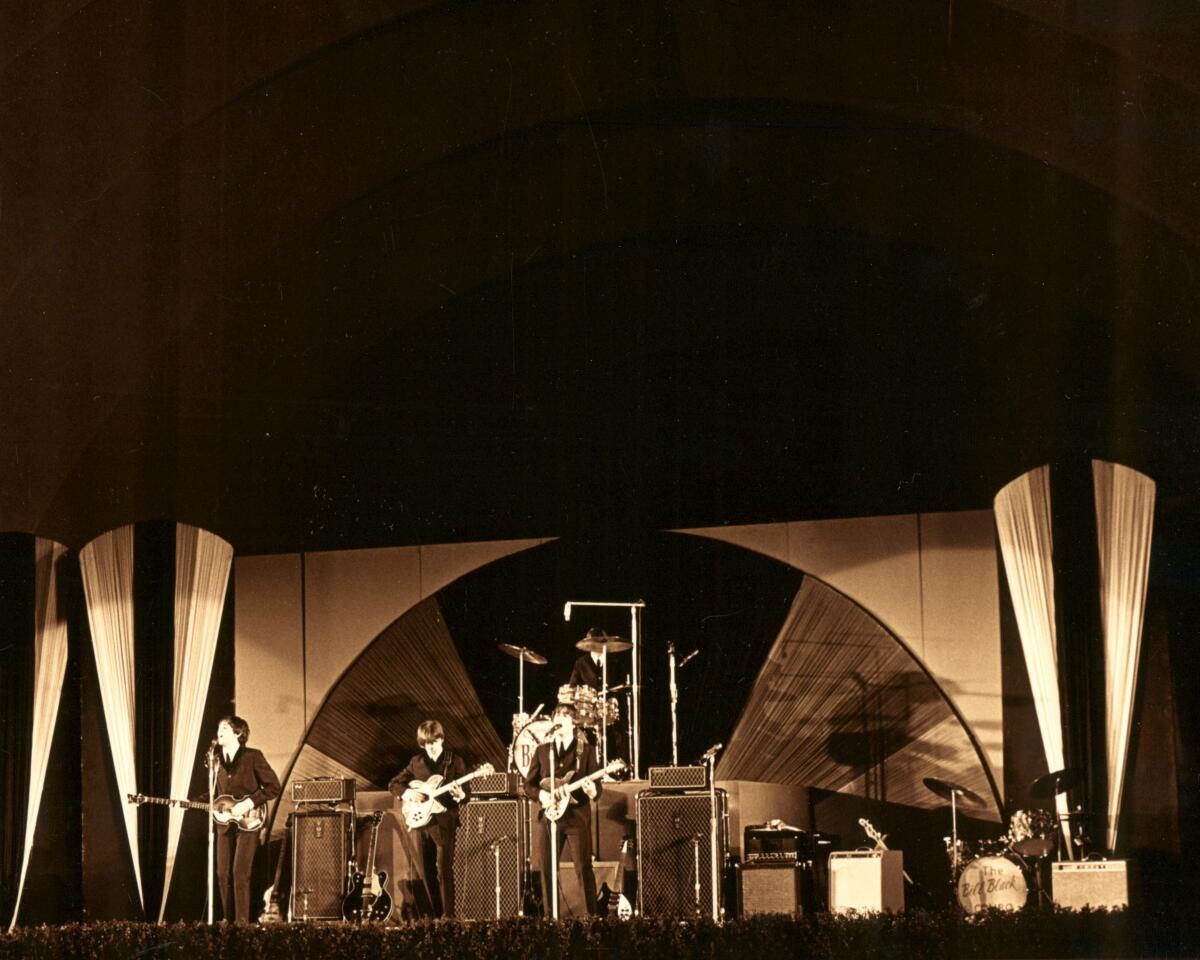
By its very nature, a visit to the Hollywood Bowl is a memorable event. Even before stepping into the venue itself, attendees might enjoy a preshow picnic, while the trek up Peppertree Lane feels like you’re hiking the final few steps of the Yellow Brick Road.
Since 1922, this journey has been made by countless music lovers, mostly fans of the classical repertoire in the early decades. The orchestral shows eventually started sharing seasons with big bands and crooners, and by the late 1950s rock ’n’ roll had earned enough attention to warrant a daylong 1958 teeny-bopper event featuring Duane Eddy, Bobby Darin, the Champs and others.
The Bowl’s pop and rock bookings increased in the early ’90s when, facing budget deficits and wide-open schedules, organizers contracted with an outside production company, Andrew Hewitt & Bill Silva Presents, to promote concerts. The relationship doubled the annual number of concerts — Live Nation became an official Hewitt Silva partner in 2018 — and The Times has covered a whole lot of them.
Here are some of the most memorable pop and rock shows at the Bowl over the last six decades, as chronicled in The Times.
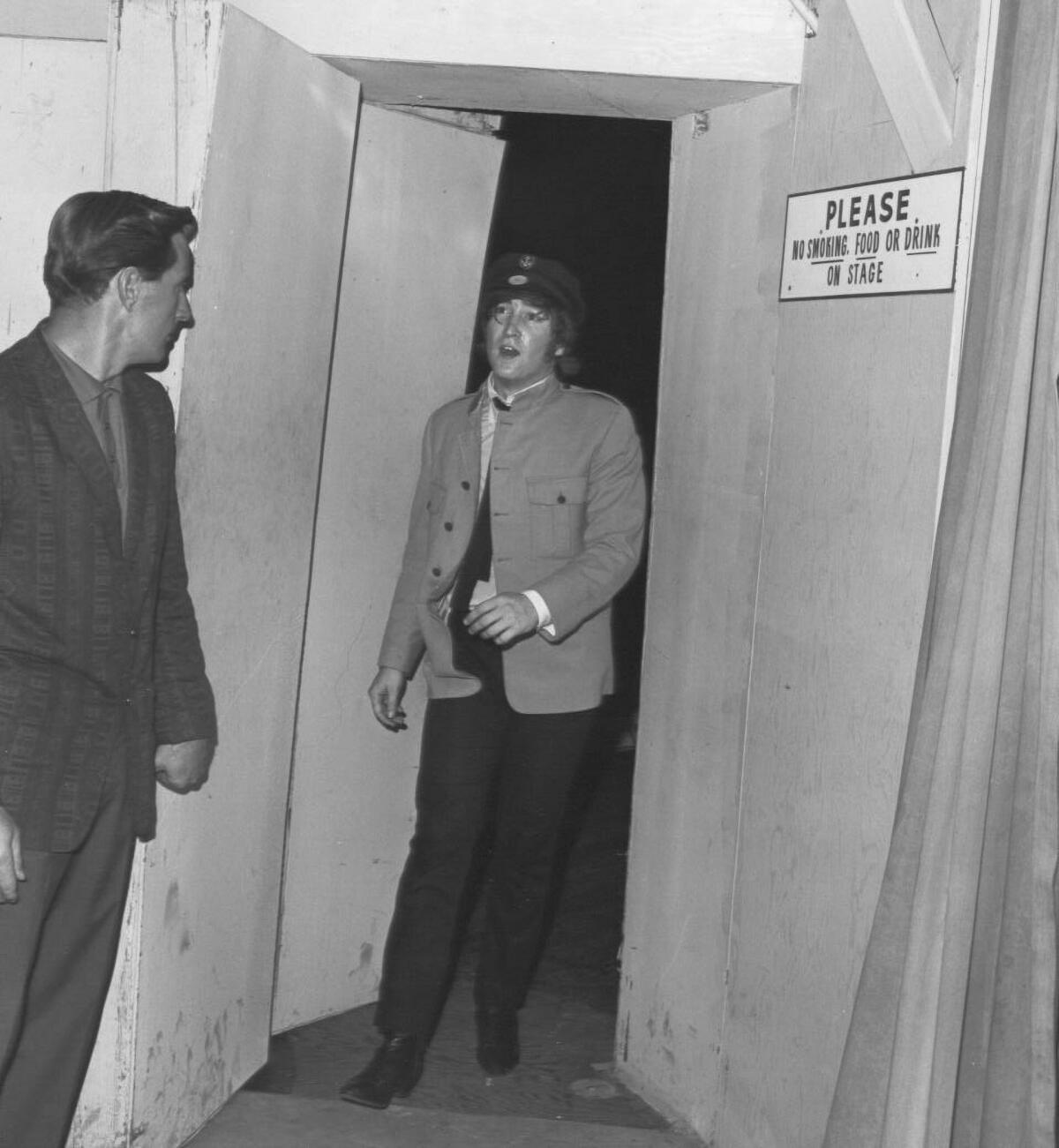
Aug. 23, 1964
The Beatles
The most famous performance ever delivered at the Bowl, the Beatles’ Los Angeles debut was greeted with the maniacal wails of fans receiving some kind of divine missive. Here’s part of The Times’ somewhat sniffy account: “With 18,700 teen-age fans shrieking hysterically, not much of the mop-haired quartet’s singing could be heard. It seemed to be enjoyed, however. After a half-hour performance, the Beatles left the stage at 10 p.m. and darted directly to a compact car parked alongside. They sped away, leaving most of their fans disconsolately watching a black limousine parked behind the Bowl as a decoy.”
July 3, 1965
The Summer Spectacular featuring the Beach Boys, Sonny & Cher, the Byrds and more
In hindsight, the Beach Boys’ gig headlining what was billed as “The Summer Spectacular” was a transformative moment. Co-founder Brian Wilson’s last show with the band for two crucial, difficult years during which he and the group wrote and recorded “Pet Sounds,” the spectacular lineup also included sets by the Kinks, Sonny & Cher, Sir Douglas Quintet, the Byrds, the Righteous Brothers, Sam the Sham & the Pharaohs and others. “If the screaming did not disturb the slumbers of Pasadena, it’s one of the larger miracles,” wrote Charles Champlin in The Times.
The Hollywood Bowl is celebrating its centennial. Learn about its history with the L.A. Philharmonic and the Beatles, Janis Joplin and more.
Sept. 3, 1965
Bob Dylan and the Band
A few months before the gig, Dylan and the Band had toured England, where he’d divided each concert into a solo acoustic first set followed by a second with a full band — electric guitars, keyboards, bass and drums. One outraged folkie in Manchester bellowed “Judas!” in response to Dylan’s amplification.
At the Bowl that fall, Dylan and the Band were similarly polarizing, if The Times’ Champlin is to be believed. “For the last half of Friday’s show [Dylan] took up electric guitar (for which he was booed at the Newport Folk Festival) and added a rock quartet behind him,” wrote Champlin. “Newport, I think, had the right idea.”
Aug. 23, 1968
Simon & Garfunkel
The New York duo first played the Bowl in 1967 opening for the Lovin’ Spoonful, and a year later they returned as headliners. In the interim, Simon & Garfunkel had recorded and released “Mrs. Robinson,” the hit single from “The Graduate.” The famed Times jazz critic Leonard Feather was tasked with assessing the concert.
Describing the set as “curiously arranged,” he noted the early arrival of “Mrs. Robinson” and added, “... then, to quote from Simon’s ‘Cloudy,’ the two just showed their faces and bent the crowd’s minds, with songs about suicide, murder, lack of communication, old age, alienation, war and bigotry, with an occasional trivial ditty (‘Feelin’ Groovy’) or a simple English folk song of love won and lost.”
July 8, 1968
The Doors
By the time the Doors first headlined the venue, singer Jim Morrison seemed bored with his success, ambivalent about fame and often stoned, tripping, drunk or some combination thereof when performing hits like “Light My Fire,” “Love Me Two Times” and “People Are Strange.” At the Bowl, wrote critic Pete Johnson, “Morrison seemed detached and subdued and mildly amused during the Doors’ set, too good-humored to work into the catatonic state which characterizes his most hypnotic — and frightening — performances.”
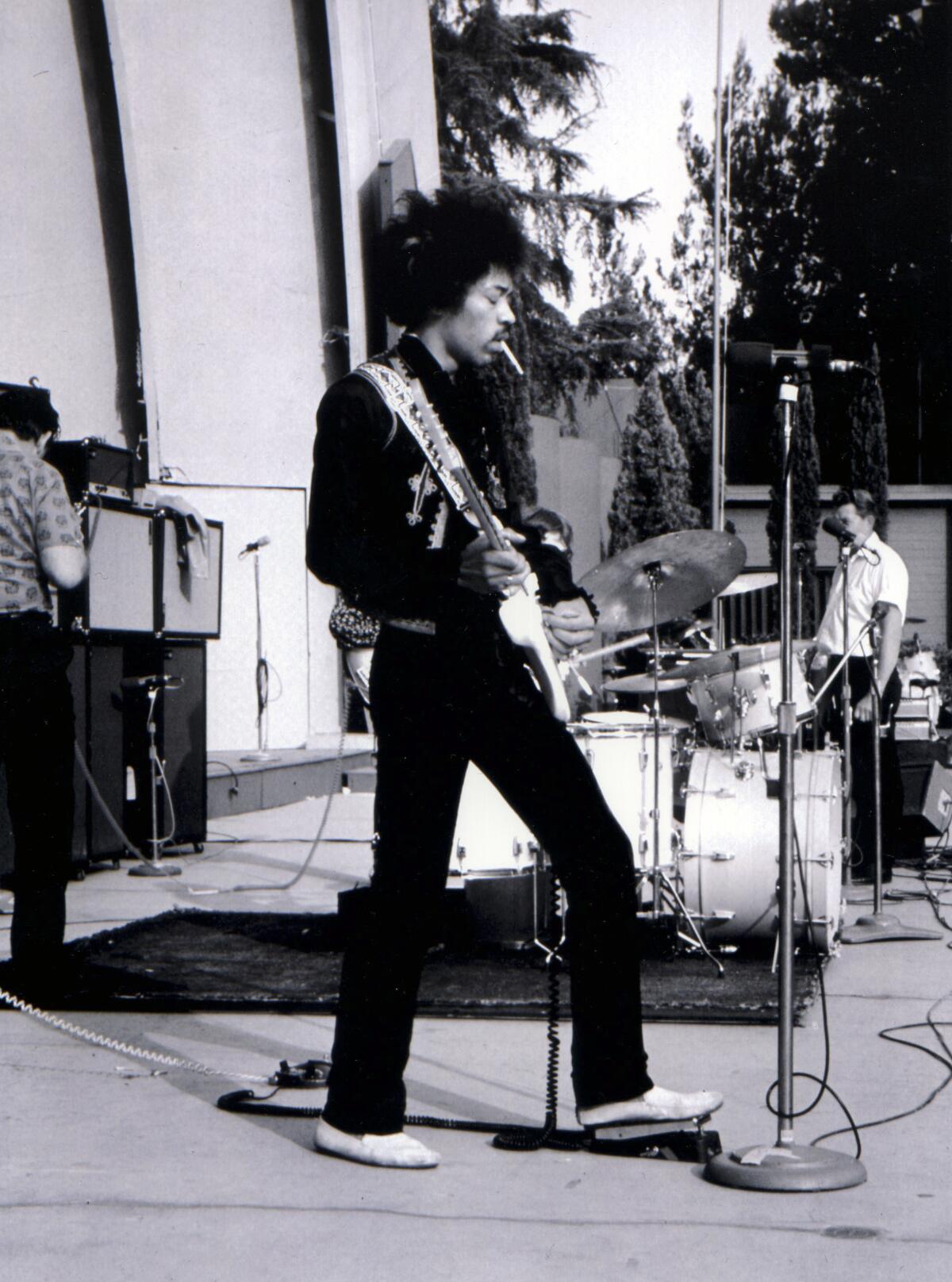
Aug. 18, 1967
Jimi Hendrix Experience
Hendrix’s shock-of-new opening set for the Mamas & the Papas at the Bowl was dismissed by The Times’ Johnson, who wrote that Hendrix “drew predictably mixed reactions from the crowd with his shrieking, feedback heavy guitar playing, sexually symbolic posturings and emotionally flat voice. ... Apparently disgruntled by the minority applause he was receiving, he did not set his guitar on fire as he has on previous occasions.”
June 23, 1973
Stevie Wonder, Rahsaan Roland Kirk, Staple Singers
In the summer of 1973, Stevie Wonder was on the cusp of releasing his brilliant “Innervisions,” experimenting with Moog and ARP synths and playing songs including “Higher Ground” and “Living for the City.” Booked to headline a Newport Jazz Festival-affiliated evening of music, Times reviewer Dennis Hunt wasn’t having it.
“Normally, a Wonder set is a buoyant experience that is littered with highlights. But his festival set was mostly flat and spiritless, as if performing there was an obligation rather than a pleasure,” wrote Hunt.
When a whiskey-swigging Janis Joplin played the bucolic Hollywood Bowl in September 1969, it was an odd match. But it left a lasting impression on Robert Hilburn.
July 1, 1974
War, Rare Earth, Graham Central Station
As with much of Hollywood, Latino and Black culture were woefully underrepresented and excluded during much of the Bowl’s first half-century. That remained true in the rock era, with the occasional exception of crossover artists such as Carlos Santana and War. Writer Hunt appeared to have fun at War, writing that “some of the songs were a bit sloppy and disorganized, but it mattered little because that tantalizing rhythm never flagged.”
June 29, 1975
Earth, Wind & Fire, Gil Scott-Heron, Weather Report
A regular presence at the Bowl for nearly 50 years, Earth, Wind & Fire’s debut performance beneath “a giant arch” was reportedly something to behold: “Just under the arch was an Earth, Wind and Fire logo that was usually flashing off and on,” critic Hunt wrote, adding that at strategic points during some numbers, “smoke bombs exploded. In the middle of one number the bassist [Verdine White] with the aid of harness and wire, suddenly became airborne and was playing his bass while dancing in the air.”
Sept. 1, 1980
Fleetwood Mac
Fleetwood Mac closed a busy year of touring in support of “Tusk” with a hometown show. Pop music critic Robert Hilburn wrote that “[o]ne of the strengths of the Los Angeles-based group is its diversity. Just when one element seemed to be wearing thin, another singer or writer stepped forward to tilt things in another direction.” Of Stevie Nicks, Hilburn noted that “she often punctuated her hauntingly ethereal tales, including ‘Rhiannon,’ with twisting and weaving motions that looked like a cross between an Indian rain dance and a witch casting a spell.”
Aug. 29, 1982
The Go-Go’s
“It’s got to be the pinnacle for us,” Go-Go’s guitarist Jane Wiedlin told Hilburn a few days before their Bowl debut. The L.A. punk band, which earned early attention four miles west on the Sunset Strip, were platinum-selling MTV stars touring in support of “Vacation” when they took the Bowl stage. “The Bowl is where I saw my first concert,” said Wiedlin. “It was Elton John — the time he had people dressed up onstage in gorilla and Frankenstein outfits. It was such a great night. I never imagined then ever being a musician, much less playing at the Bowl.”
June 24, 1990
Mariachi USA
For the majority of the nonwhite population of Los Angeles County, the Bowl was long this vaunted place on the other side of town that seemed to have little interest in the Mexican music that soundtracked everyday life. That changed when, in 1990, promoter Rodri Rodriguez successfully pitched the idea of celebrating mariachi music, which at the time was more appreciated in Southern California than in its birthplace of Mexico. Mariachi USA has since become the most prominent festival of its kind in the world.
Reviewer Enrique Lopetegui captured the opening moments of one early installment of Mariachi USA, writing, “The crowd’s dual heritage was expressed at the start of the show, with an a cappella rendition of the Mexican national anthem followed by a moving, eight-trumpet version of ‘The Star-Spangled Banner.’”
Oct. 27, 2001
Jane’s Addiction, Courtney Love
How’s this for an opening, courtesy of Jane’s Addiction founder Perry Farrell — and reviewer Natalie Nichols: “It’s always surprising that the leader of a group so steeped in self-absorbed dementia, twisted Zeppelin riffs and art rock decadence could be so bent on positivity, but of course it’s a delightfully warped and sexual brand, underscored Saturday by Farrell’s entrance in a billowing white parachute skirt, from which emerged a coterie of half-naked, sinuous dancers.” Love, recovering from Hole’s recent implosion, opened and, wrote Nichols, “playfully introduced her ensemble as Molly Hatchet, chastised people for eating during her set, tossed a pumpkin from the stage, danced with audience members and jokingly mocked Farrell.”
Oct. 21, 2005
Gwen Stefani, Black Eyed Peas
Not long after Stefani took a hiatus from No Doubt and hit the top of the charts with “Hollaback Girl,” The Times’ Randy Lewis reviewed her headlining set: “This hit is B-A-N-A-N-A-S,” he wrote. “At the Bowl, she turned it into a full-fledged high school football game cheer-along — Stefani outfitted as the snazziest-looking drill-team leader in history while her four dancing Harajuku Girls appeared in cheerleader tops and skirts.” But, Lewis concluded, “Such indulgence may be fun, but it doesn’t translate into a new reason to respect her artistry.”
April 16, 2008
Jay-Z, Mary J. Blige, The-Dream
Like many major concert venues across the country, the Bowl was reluctant to book rap artists until long after the movement had conquered music culture. When N.W.A, Dr. Dre and Snoop Dogg were redefining the definition of the West Coast sound, the Bowl’s schedule of pop concerts included Sting, Michael Bolton, Celine Dion and Morrissey.
By the time Jay-Z, Mary J. Blige and The-Dream converged on the venue in 2008, only a half-dozen rappers had headlined the Bowl — and Kid Rock accounted for two of them. The Times’ Richard Cromelin raved about Jay-Z’s show: “Wisely rejecting such rap-show conventions as dancers and a crowd of associates, Jay-Z kept the stage lean and took advantage of the live musicians who teamed with his DJ. That made for a powerful and varied sound ... .”
June 28, 2009
Adele, Chaka Khan, Janelle Monáe
When Adele signed on to play at the Hollywood Bowl alongside Etta James and Janelle Monáe as part of the annual KCRW World Festival series of concerts in early 2009, national stardom was a few months away, wrote The Times’ Karen Wada in advance of the show. “The Bowl had signed Adele even before this year’s Grammys, where she won two awards, including best new artist.” Expressing concern about selling out the venue, Adele noted that she was relieved when Bowl producers booked her alongside James and an up-and-coming Monáe. “It blew my mind,” Adele told The Times before the concert in 2009, of playing on a bill with James. “She’s the reason I started. The first time I heard her voice, it sucked me in. Made me believe, and made me cry.” Unfortunately, poor health forced James to cancel on short notice. Luckily Khan stepped in — and fans were treated to sets by a legend two soon-to-be stars.
Oct. 6, 2012
Peter Gabriel
Many only-in-Hollywood moments have occurred in the Cahuenga Pass institution, none more so than this scene laid out in The Times in 2012, when Peter Gabriel was greeted by the star of “Say Anything,” a beloved movie that features a climactic scene soundtracked by the singer’s “In Your Eyes.” Gabriel, wrote The Times’ Lewis, “was at the heart of another confluence of music, memory and imagery when actor John Cusack wandered onstage with a large boombox. He presented it to Gabriel, who then hoisted it over his head in a nod to the classic scene from Cameron Crowe’s 1989 film ‘Say Anything’ … .”
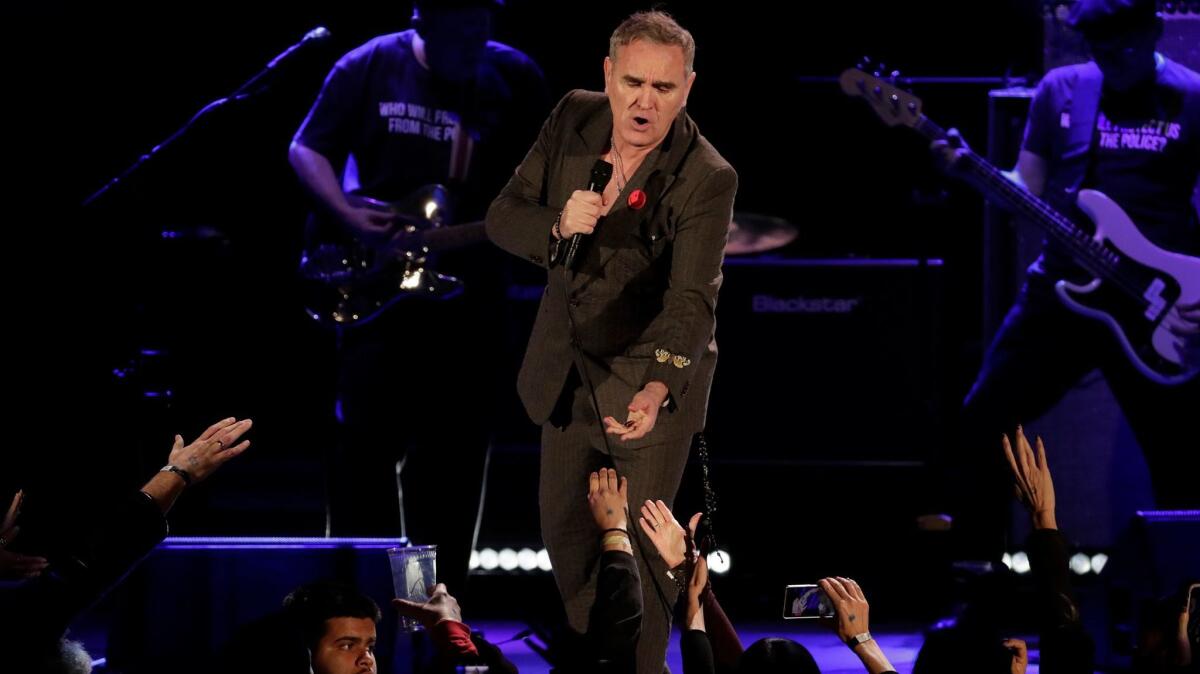
Nov. 10, 2017
Morrissey
A decades-long L.A. resident, the English-born Morrissey has become an adopted son. That relationship — and his outspoken politics — were on full display in the fall of 2017, wrote Times critic Mikael Wood. “Arrayed behind him like a front row of marchers, the members of his backing band wore black T-shirts that read, ‘Who will protect us from the police?’ In ‘Glamorous Glue, he tweaked a lyric about Britain’s Conservative Party to criticize Republicans; later, ‘Shoplifters of the World Unite’ ... was accompanied by an image of President Trump as a bawling infant.”
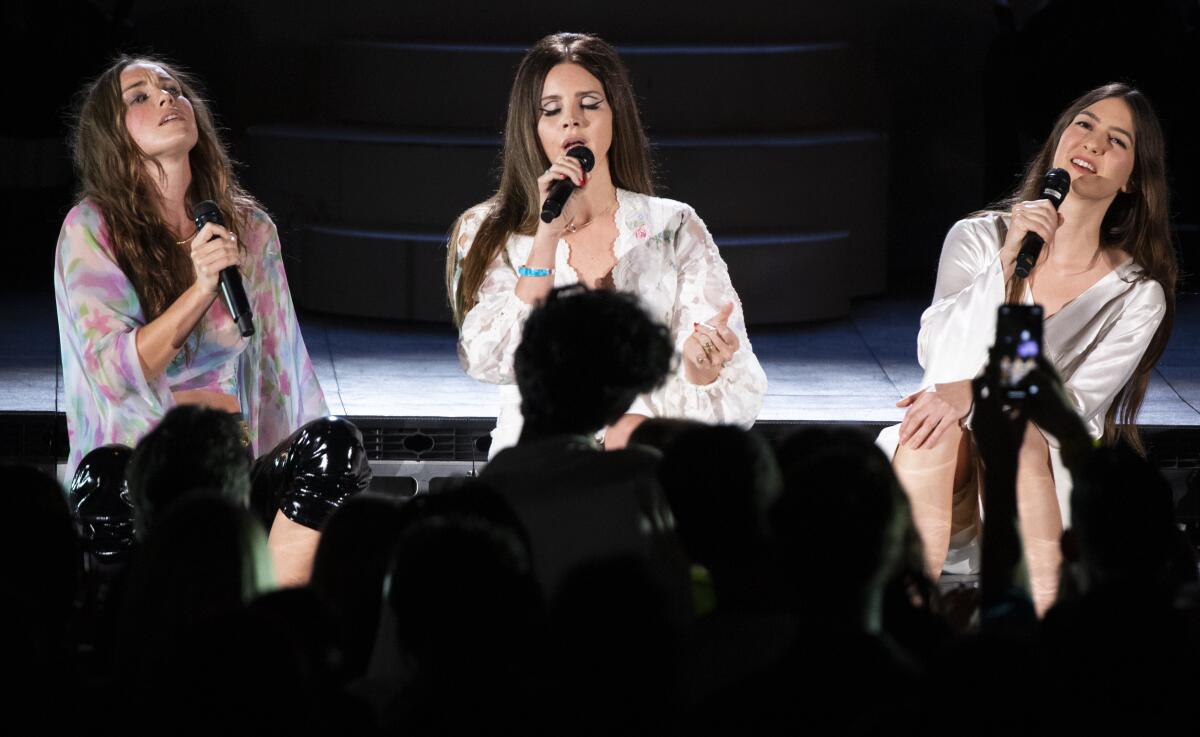
Oct. 10, 2019
Lana Del Rey
Though she didn’t know it at the time, the Hollywood Bowl would be Lana Del Rey’s final L.A. concert before the pandemic. Blissfully unaware, she and the crowd were celebrating the success of her then-new record “Norman F— Rockwell!” Del Rey did so, wrote Wood, by inviting some guests. “She brought out Chris Isaak in a sparkly suit to do ‘Wicked Game,’ his decades-old rockabilly slow jam, which Del Rey described as ‘the sexiest song of all time.’ ... For ‘Hope Is a Dangerous Thing for a Woman Like Me to Have — But I Have It,’ Del Rey was accompanied on piano by Jack Antonoff, who produced the new album, and here she sang as well as she did all night, slurring her words with a seemingly contradictory precision that only made her images of ‘confusion and quiet collusion’ more chilling.”
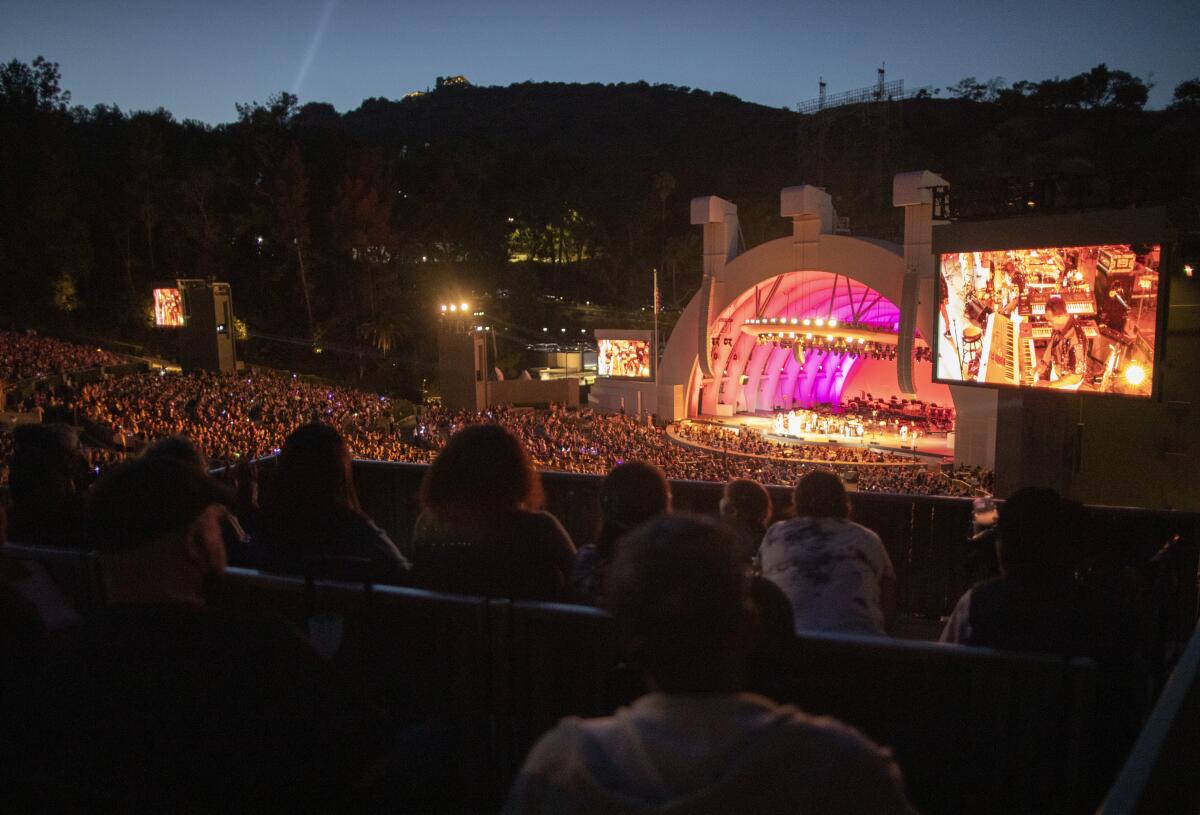
July 3, 2021
Kool & the Gang
Before 2020, the Bowl hadn’t canceled a full season in nearly a century, and its absence was apparent when Wood reviewed the annual “July 4th Fireworks Spectacular,” which featured headliners Kool & the Gang. “Hey, hey, hey, COVID go away,” said the band’s Robert “Kool” Bell at the start of the concert, “cause we want to play.”
Wrote Wood: “’Hallelujah!’ said one concertgoer, Chandra Talley, as she enjoyed the evening with a large group that included her daughter and grandchildren. ‘It feels wonderful to be back. I’m an L.A. city girl, and this is all of L.A. right here.’”
More Coverage: Hollywood Bowl
More to Read
The biggest entertainment stories
Get our big stories about Hollywood, film, television, music, arts, culture and more right in your inbox as soon as they publish.
You may occasionally receive promotional content from the Los Angeles Times.
